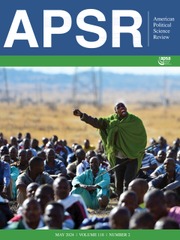Crossref Citations
This article has been cited by the following publications. This list is generated based on data provided by
Crossref.
Parker, Dominic P.
Foltz, Jeremy D.
and
Elsea, David
2016.
Unintended Consequences of Sanctions for Human Rights: Conflict Minerals and Infant Mortality.
The Journal of Law and Economics,
Vol. 59,
Issue. 4,
p.
731.
Blair, Robert
Blattman, Christopher
and
Hartman, Alexandra
2016.
Predicting Local Violence: Evidence from a Panel Survey in Liberia.
SSRN Electronic Journal,
Blair, Robert A
Blattman, Christopher
and
Hartman, Alexandra
2017.
Predicting local violence.
Journal of Peace Research,
Vol. 54,
Issue. 2,
p.
298.
Hirose, Kentaro
Imai, Kosuke
and
Lyall, Jason
2017.
Can civilian attitudes predict insurgent violence? Ideology and insurgent tactical choice in civil war.
Journal of Peace Research,
Vol. 54,
Issue. 1,
p.
47.
Blattman, Christopher
Jamison, Julian C.
and
Sheridan, Margaret
2017.
Reducing Crime and Violence: Experimental Evidence from Cognitive Behavioral Therapy in Liberia.
American Economic Review,
Vol. 107,
Issue. 4,
p.
1165.
Gomila, Robin
Littman, Rebecca
Blair, Graeme
and
Paluck, Elizabeth Levy
2017.
The Audio Check.
Social Psychological and Personality Science,
Vol. 8,
Issue. 4,
p.
424.
Martin-Shields, Charles
2017.
State Fragility as a Cause of Forced Displacement: Identifying Theoretical Channels for Empirical Research.
SSRN Electronic Journal ,
Rohner, Dominic
2017.
Emerging Trends in the Social and Behavioral Sciences.
p.
1.
Lyall, Jason
Zhou, Yang-Yang
and
Imai, Kosuke
2017.
Reducing Insurgent Support among At-Risk Populations: Experimental Evidence from Cash Transfers and Livelihood Training in Afghanistan.
SSRN Electronic Journal,
NELLIS, GARETH
and
SIDDIQUI, NILOUFER
2018.
Secular Party Rule and Religious Violence in Pakistan.
American Political Science Review,
Vol. 112,
Issue. 1,
p.
49.
de Chaisemartin, Clement
and
Behaghel, Luc
2018.
Next Please! Estimating the Effect of Treatments Allocated by Randomized Waiting Lists..
SSRN Electronic Journal ,
Stoop, Nik
Verpoorten, Marijke
van der Windt, Peter
and
Wilson, Rick K.
2018.
More legislation, more violence? The impact of Dodd-Frank in the DRC.
PLOS ONE,
Vol. 13,
Issue. 8,
p.
e0201783.
Littman, Rebecca
2018.
Perpetrating Violence Increases Identification With Violent Groups: Survey Evidence From Former Combatants.
Personality and Social Psychology Bulletin,
Vol. 44,
Issue. 7,
p.
1077.
Karell, Daniel
and
Schutte, Sebastian
2018.
Aid, exclusion, and the local dynamics of insurgency in Afghanistan.
Journal of Peace Research,
Vol. 55,
Issue. 6,
p.
711.
Redo, Sławomir
2018.
On Education in the Global Culture of Lawfulness.
Białostockie Studia Prawnicze,
Vol. 23,
Issue. 3,
p.
27.
Harada, Masataka
and
Smith, Daniel M.
2019.
Distributive Politics and Crime.
SSRN Electronic Journal,
Christiaensen, Luc
and
Vandercasteelen, Joachim
2019.
Accelerating Poverty Reduction in Africa.
p.
95.
Couttenier, Mathieu
Petrencu, Veronica
Rohner, Dominic
and
Thoenig, Mathias
2019.
The Violent Legacy of Conflict: Evidence on Asylum Seekers, Crime, and Public Policy in Switzerland.
American Economic Review,
Vol. 109,
Issue. 12,
p.
4378.
Khanna, Gaurav
Medina, Carlos
Nyshadham, Anant
Posso, Christian
and
Tamayo, Jorge
2019.
Kreutz, Joakim
and
Nussio, Enzo
2019.
Destroying Trust in Government: Effects of a Broken Pact among Colombian Ex-Combatants.
International Studies Quarterly,
Vol. 63,
Issue. 4,
p.
1175.


Comments
No Comments have been published for this article.